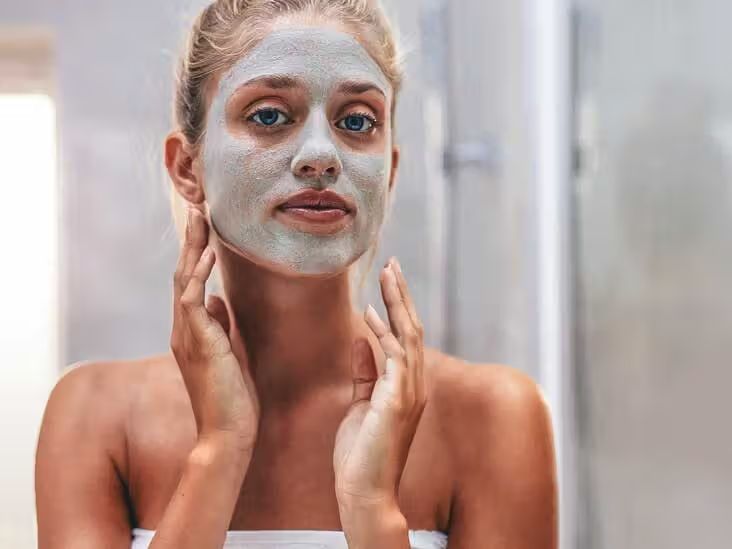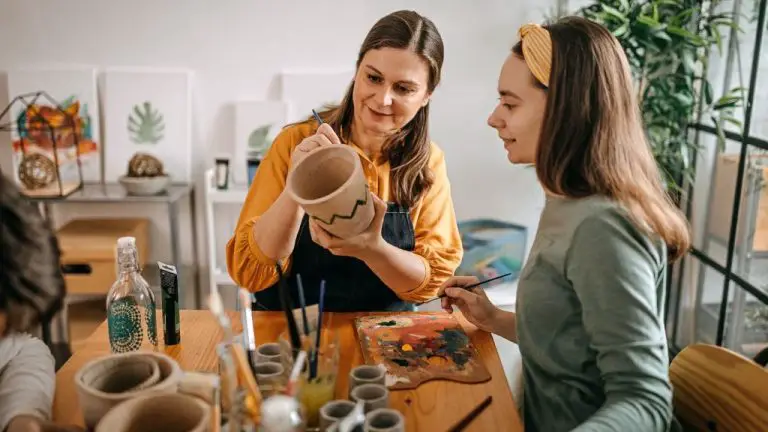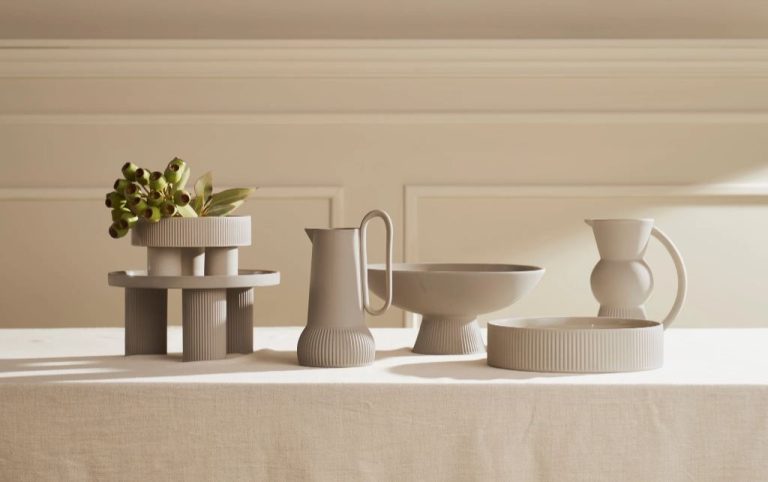How Do You Add Speckle To Glaze?
Speckle glaze refers to a type of ceramic glaze that contains small flecks or spots of color scattered throughout a base glaze. The speckles add visual interest, texture, and depth to finished pottery pieces. The speckles are created by adding metallic oxides, stains, underglazes, or insoluble particles to the glaze before application.
There are several techniques ceramic artists use to produce a speckled effect. The speckling materials can be mixed directly into the glaze. They can also be sprinkled or splattered onto wet glaze. Using a resist material to block out sections before glazing is another option. The size and density of speckles depends on the speckling material used and the method of application.
Reasons for Adding Speckle
Adding speckle to pottery glazes serves several aesthetic and functional purposes. Speckles create visual interest and texture on an otherwise uniform glaze surface. The spots also help hide small imperfections in the clay body like pinholes or cracks. Glaze speckling provides decorative variation without requiring extensive skill or special techniques.
Speckles boost the visual appeal of finished ware by making the surface more dynamic. The scattered spots generate movement and make the eye travel across the glazed object. This added visual energy enhances the aesthetic qualities of the piece. Speckling helps prevent the glaze from looking flat and dull.
The speckles also disguise flaws like tiny pits, cracks, or uneven spots in the clay body. The glaze pools in these imperfections, creating dark spots that draw the eye. This masks small defects that may detract from the appearance. Speckling enables potters to salvage wares with minor flaws that otherwise may be considered seconds.
In addition to visual interest, speckles provide tangible texture and dimension. The spots give the glaze physical depth that can be felt. Speckling adds tactile variety to smooth glazed surfaces. The textural properties resulting from speckling expand decorative possibilities.
Types of Materials to Create Speckles
There are several types of materials that can be used to create speckles in glaze:
Ceramic Stains – These are concentrated colorants made of metal oxides that can produce vibrant speckles. They are formulated to be stable at high temperatures. Popular options are cobalt, copper, and manganese stains.
Underglazes – Underglazes applied on top of an unfired glaze can produce speckles as they fuse into the surface during firing. Consider using black, brown, blue, green underglazes depending on the look you want.
Overglazes – Overglazes are low-fire colorants that produce bright speckles on bisqueware before a glaze is applied. Some overglazes can also be used on top of glazes. Metallic overglazes like gold, silver, and copper work well.
Oxides – Metal oxides like iron, cobalt, copper, and rutile can create bold, rugged speckles. They are inexpensive and offer broad color options. Too much oxide though can cause crawling issues.
Engobes – Slip-like mixtures of clays and fluxes called engobes can be applied on bare or glazed clay to make speckles. Consider a black, brown, blue, or white engobe over a contrasting glaze.
Application Techniques
There are several techniques you can use to apply speckles to glazed ceramic pieces. Each method provides a slightly different effect.
Spraying
Spraying speckle material through an atomizer or spray bottle allows you to evenly distribute small speckles across the entire surface of the piece. You get a fine, consistent speckling effect. Make sure to spray from at least 12 inches away so the speckles don’t become too large.
Spattering
Using a stiff bristle brush, you can spatter speckle material onto the glazed piece by flicking the brush over the surface. This creates randomly dispersed speckles of various sizes. Play with flicking the brush gently versus more aggressively to control speckle size and density.
Splattering
Splattering involves using your finger or a chopstick to tap and splatter speckle material onto the glaze. Dip your finger or the chopstick into the speckle mixture and then tap it over the piece to free-hand splatter. This method also creates speckles of varying sizes.
Splashing
For a splash effect, dip a stiff brush into the speckle mixture and then tap the bristles against a stick held just above the piece. This will send speckle droplets splashing onto the surface. Varying the height of the stick gives you some control over speckle size.
Trailing
Drawing or trailing the speckle material over the glazed piece with a brush allows you to create speckled lines and designs. Let your creativity guide you here. Try making zig-zags, dots, dashes or squiggles.
Pouring
For a bolder, denser speckling, you can carefully pour or drizzle the speckle mixture over all or sections of the glazed piece. Tilting the piece as you pour lets gravity guide the flow. Go slowly so you can control the look. The poured sections will be much more heavily speckled.
Speckle Size and Density
When adding speckles to glaze, you’ll want to consider the size and density of speckles for the desired effect. Generally, smaller speckles will create a finer overall texture while larger speckles make bolder statements. The amount of speckling material you add to the glaze will impact density.
For a light dusting of fine speckle, add just a small amount of speckling material and limit particle size to 1mm or less. This creates an almost smooth glazed surface with hints of texture. For medium speckling, use particles around 2-3mm and a moderate amount of material. The speckles will be more visible but not overpowering. For very heavy speckling, use larger particles around 5mm and add a lot of material. This creates a pronounced speckled effect with spackled areas of thick texture.
Test batches to see speckle size and density results. Vary the particle dimensions and amount you add to find the sweet spot. Often a mix of particle sizes creates appealing complexity. Consider the clay body and intended firing temperature as higher temps may increase speckle size slightly. Use speckle layers purposefully to control areas of light vs heavy speckling. With practice, you can achieve beautiful custom speckled effects by managing speckle size and density.
Layering Speckled Glazes
Using multiple layers of speckled glazes can create incredible depth and visual complexity. Start with a base glaze in your choice of color. Apply speckles using a contrasting color, like black speckles over a white base. Allow the first layer to dry before adding another speckled layer. Consider alternating the speckle colors, sizes, or densities between layers. You can also layer both speckled glazes and solid glazes. The combinations are endless!
When layering speckled glazes, keep in mind the firing temperature requirements. Make sure all the glazes and speckles used can be fired together. Test compatibility on glaze test tiles before applying to pottery. Pay attention to the order of application too. Start with the lightest or most subtle layers first, adding bolder and darker effects on top.
With careful layering, you can make speckled effects look three-dimensional. Use larger speckles on the bottom layers and smaller ones near the top. This creates visual depth, making speckles appear to recede into the distance. Layering also allows colors to mingle and interact in exciting ways. Just be sure to leave adequate drying time between coats for the best results.
Complementary Glazes and Speckles
When adding speckles to glazes, it’s important to consider how the speckle color will interact with the base glaze color. Choosing speckle colors that complement or contrast the base glaze in pleasing ways takes some experimentation and an understanding of color theory.
Usually, analogous colors (colors next to each other on the color wheel) make attractive speckle combinations. For example, a blue glaze with purple speckles or a green glaze with yellow speckles. Monochromatic speckles in lighter and darker shades of the base glaze also give subtle, elegant effects.
Complementary colors (opposite on the wheel) make bold accents. A blue glaze with orange speckles or a green glaze with red speckles packs visual impact. Keep complementary speckles sparser and smaller to prevent a jarring look.
When a glaze has strong color saturation or intensity, pale tints of that hue or neutral speckles are soothing complements. Conversely, pale or neutral glazes come alive with vivid, highly saturated speckles.
Consider the desired aesthetic and mood of the finished piece when selecting speckle colors. Energizing, vibrant speckles or serene, harmonious ones? Contrasting speckles for drama or analogous speckles for subtlety? Thoughtfully chosen speckle colors can enhance the base glaze beautifully.
Firing Speckled Pieces
Proper firing is essential for achieving the desired speckled effects in glazes. The key considerations are ensuring the speckles melt and adhere without excessively bloating or burning off.
The speckle material and glaze base need to be compatible in terms of temperature. Speckles with high flux materials like soda ash or feldspar require higher kiln temperatures around cone 6. Materials like silicon carbide can speckle well at lower temperatures like cone 04.
Do test tiles first to verify the speckle melt and glaze appearance. Slow bisque and glaze firing cycles around 100°F per hour can allow speckles time to gradually melt without bloating. A soak period at peak temperature allows speckles to fully fuse.
Insufficient melt may leave speckles too prominent, while too rapid heat can make them expand and distort. Overfiring can cause speckles to burn off completely. Optimal firing depends on the speckle material, glaze type, and kiln atmosphere.
With care in firing, beautiful speckled effects can be achieved on finished ceramic pieces. Proper testing and adjustment of the firing profile will help ensure the speckles adhere attractively without defects.
Troubleshooting Issues
When working with speckled glazes, you may encounter some common issues like pinholes, crawling, or insufficient melt. Here are some troubleshooting tips:
Pinholes
Small unwanted holes or pits in the glaze surface are known as pinholes. They are caused by air bubbles getting trapped in the glaze. To prevent pinholes:
- Apply glazes in thinner coats to reduce trapped air bubbles.
- Use a painting technique like spraying or dipping rather than brushing.
- Strain glazes through a mesh sieve or paint filter.
- Increase firing temperature slightly to allow glaze to flow and fill in pinholes.
Crawling
When glaze clumps up and pulls away from the clay surface, this effect is called crawling. It’s generally caused by incompatible clay and glaze combinations. To fix crawling:
- Use a clay body specifically formulated for the glaze.
- Apply a very thin first coat of glaze to increase absorption.
- Bisque fire clay at a higher temperature before glazing.
- Adjust glaze consistency by adding water, vinegar, or gum solution.
Insufficient Melt
If speckles remain rough and unmelted after firing, the glaze likely needs a higher temperature. To fully melt speckles:
- Check your kiln for accurate temperature.
- Increase firing temperature by 25-50°F.
- Extend the time at peak temperature.
- Switch to a more robust base glaze.
Inspiring Examples
Speckles can add vibrancy and visual interest to ceramic glazes. Here are some inspiring examples of creative ways artists are using speckles in their ceramic work:

This brightly colored bowl has a textured blue glaze with red and white speckles sprinkled throughout, giving it an eye-catching, confetti-like look.

The white glaze on this mug is brought to life with tiny black speckles in different sizes, almost resembling stars in the night sky.

Here a vase has been dipped in a clear glaze and then speckled lightly with small black dots, creating a subtle yet artistic effect.
As you can see, speckles can be bold and prominent or delicate and understated. They add visual complexity and interest to glazed ceramic pieces. Let these inspiring examples spark your creativity next time you want to add speckles to your own ceramic glazes and projects.



